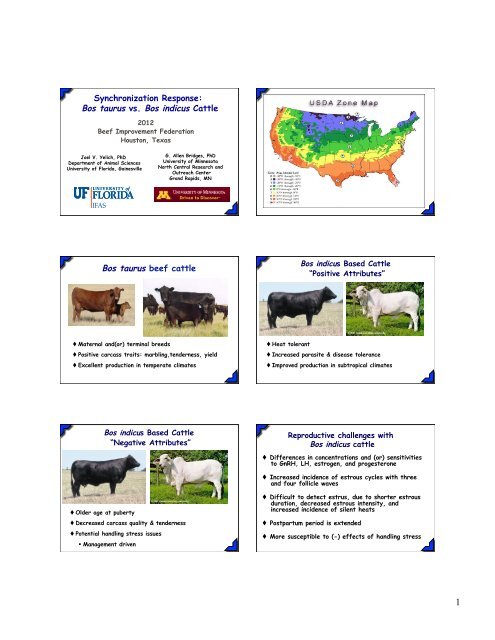Bos taurus vs. Bos indicus - Beef Improvement Federation
Bos taurus vs. Bos indicus - Beef Improvement Federation
Bos taurus vs. Bos indicus - Beef Improvement Federation
Create successful ePaper yourself
Turn your PDF publications into a flip-book with our unique Google optimized e-Paper software.
Synchronization Response:<br />
<strong>Bos</strong> <strong>taurus</strong> <strong>vs</strong>. <strong>Bos</strong> <strong>indicus</strong> Cattle<br />
2012<br />
<strong>Beef</strong> <strong>Improvement</strong> <strong>Federation</strong><br />
Houston, Texas<br />
Joel V. Yelich, PhD<br />
Department of Animal Sciences<br />
University of Florida, Gainesville<br />
G. Allen Bridges, PhD<br />
University of Minnesota<br />
North Central Research and<br />
Outreach Center<br />
Grand Rapids, MN<br />
<strong>Bos</strong> <strong>taurus</strong> beef cattle<br />
<strong>Bos</strong> <strong>indicus</strong> Based Cattle<br />
“Positive Attributes”<br />
Maternal and(or) terminal breeds<br />
Positive carcass traits: marbling,tenderness, yield<br />
Excellent production in temperate climates<br />
Heat tolerant<br />
Increased parasite & disease tolerance<br />
Improved production in subtropical climates<br />
<strong>Bos</strong> <strong>indicus</strong> Based Cattle<br />
“Negative Attributes”<br />
Reproductive challenges with<br />
<strong>Bos</strong> <strong>indicus</strong> cattle<br />
Differences in concentrations and (or) sensitivities<br />
to GnRH, LH, estrogen, and progesterone<br />
Increased incidence of estrous cycles with three<br />
and four follicle waves<br />
Older age at puberty<br />
Decreased carcass quality & tenderness<br />
Potential handling stress issues<br />
Management driven<br />
Difficult to detect estrus, due to shorter estrous<br />
duration, decreased estrous intensity, and<br />
increased incidence of silent heats<br />
Postpartum period is extended<br />
More susceptible to (-) effects of handling stress<br />
1
Synchronization Systems<br />
Producer Perspective<br />
MANIPULATING THE ESTROUS CYCLE<br />
Cost effective<br />
Ease of implementation<br />
Minimal cattle handlings<br />
Regulation of CL<br />
regression<br />
Synchronization<br />
of follicular<br />
growth & inducing<br />
ovulation for<br />
timed-AI<br />
Prevent<br />
expression of<br />
estrus and<br />
induce estrous<br />
cycles<br />
Yield consistent & acceptable pregnancy rates<br />
Fit into producers operation<br />
Meet their goals and objectives<br />
Physical & labor resources<br />
ProstaglndinF 2<br />
(PG)<br />
GnRH<br />
Progestogens<br />
(MGA)<br />
(CIDR)<br />
Table 1. Commonly used hormones in estrous synchronization and their trade names a .<br />
Hormone (Abbreviation)<br />
Gonadotropin Hormone<br />
Releasing Hormone (GnRH)<br />
Progestins<br />
Progesterone<br />
Synthetic progestin<br />
Prostaglandin F 2"<br />
(PGF)<br />
Commercial Products b<br />
Cystorelin ! , Factrel ! , Fertagyl ! , OvaCyst !<br />
CIDR ! , Intravaginal progesterone-releasing insert<br />
Melengestrol acetate (MGA ! ), Orally-active feed<br />
additive<br />
Lutalyse ! , Estrumate ! , ProstaMate ! , estroPLAN, In-<br />
Synch<br />
a Table adapted from M.L. Day and D.E. Grum, The Ohio State University<br />
b<br />
The commercial products often do not have the same chemical composition as the hormone<br />
produced by the animal’s body. In many cases, these compounds have similar effects on the<br />
reproductive system as the native hormone. Please read and follow label instructions when<br />
using these products.<br />
Estrous Synchroniza0on Terminology <br />
Estrous Response <br />
Percentage of females that exhibited estrus during <br />
synchronized period <br />
Concep;on Rate <br />
Percent of heifers that conceived to AI of those that <br />
exhibited estrus <br />
Timed-‐AI Pregnancy Rate <br />
Percentage of females that became pregnant following <br />
a ;med-‐AI <br />
AI or Synchronized Pregnancy Rate <br />
Percentage of females that became pregnant <br />
to AI of total treated <br />
<strong>Beef</strong> Heifer Synchronization<br />
MGA + PG<br />
Estrus<br />
(Low fertility)<br />
Synchronized<br />
Estrus & AI<br />
MGA (14 days)<br />
PG<br />
1 14 16 20 31 33 38<br />
Treatment days<br />
Brown et al., 1988<br />
2
Yearling <strong>Bos</strong> <strong>taurus</strong> beef heifers<br />
synchronized with MGA + PG<br />
TRT #<br />
Estrous<br />
Rate (%)<br />
Conception<br />
Rate (%)<br />
AI Pregnancy<br />
Rate (%)<br />
Brown et al., 1988 157 83.0 69.0 57.0<br />
Patterson, 1990 323 83.0 74.0 61.0<br />
$ %'%&" %<br />
!"# $%<br />
56("7018"9*(:6(;"701"
,-.-/0%,1"/2%3%&'(# ) %4"5%6+' %<br />
4-./"2-/-5/".12"67"2.3"#"/8"$!".12",67".99"181:<br />
*-+;812-*+"#%:'(")8?"@A/)"?1B4"./",67"<br />
!"#$%<br />
&'(# )% *!%<br />
#%"&"'(")*+"<br />
!"#$%<br />
+'%<br />
!" #" $!"<br />
,*-./0-1/"2.3"<br />
4-./"2-/-5/".12"67""<br />
*!%<br />
,-(./%&0-1/"23%4%&'(# )%<br />
2+(34(."*56"%!"-4"%%"'",3-+("27"89-'"7/:;",-"*56""<br />
!"#$%<br />
!"#$%<br />
&'(# )% %!"&"%%"'()"<br />
+'%<br />
!"<br />
*(+,-.+/-"0,1"<br />
#" $!"<br />
+,(-.%&/,0."12%3%&'(# )%<br />
3,&45&/"+67"*$"#"$"%"-4.,&".%,"89&'."3:";9.%":0,?.950'"54"3:"@!"#"$"%&'A"-&,"&,BC9&,1"45&".%9'"D&5.5?5E""""""""<br />
!"#$%<br />
!"#$%<br />
4!%<br />
*'%<br />
!"#"$"<br />
&'(# )% %&'" *$"#"$"%&'"<br />
(" )" !"<br />
+&,-./,0."1-2"<br />
!<br />
!"#$%&'(&)*+,"-./*0&*1&23&,-%40"056&-"7%/&#%78%%0&79%&:;<br />
;;9?@?09%+,(-.%/01023%/."24%5%&'(# )% 6%7*'%8=>9: %<br />
&'(# )% 2'3#<br />
!"#$%<br />
>
Working Hypothesis <br />
Reducing progesterone concentra5ons during development <br />
of the follicular wave would: <br />
Progesterone causes an LH (Roberson et al., 1989; Dias et al., 2009) <br />
Increase dominant follicle growth and diameter (Carvalho et al., 2008) <br />
Increase pre-‐ovulatory estradiol produc5on (Sirois and Fortune, 1990) <br />
Enhance oocyte viability (Revah and Butler, 1996) <br />
Enhance subsequent luteal func5on (Butler et al., 1996) <br />
Increase estrous response and concep5on rates <br />
to AI and 5med-‐AI <br />
Courtesy Brandy Sparks, Purdue <br />
!"#$%&'(&)%*+,-./012%&*%+3,+4"5/%&,3&6%"+$157&#%%3&8%13%+9&,3&<br />
!"#$%&'('#&#+%%-157&&<br />
!)!& 5!<br />
:90+,.9&<br />
)%9*,59%;&
<strong>Beef</strong> Cow Synchronization<br />
Anestrus in US beef cattle at start of<br />
synchronization<br />
Suckling calf<br />
Decreased percentage of estrous cycling cows at breeding<br />
Synchronization response<br />
• Dependent on nutritional status pre-calving<br />
Percentage cycling<br />
Range<br />
8-69%<br />
2212 cows<br />
12 locations<br />
69 dpp<br />
Range<br />
17-67%<br />
851 cows<br />
6 locations<br />
56 dpp<br />
Lucy et al., 2001; Larson et al., 2006<br />
Range<br />
6-81%<br />
724 heifers<br />
5 locations<br />
14.7 months<br />
1 3<br />
5 7<br />
Effectiveness of the CIDR to induce estrus in<br />
lactating anestrous (non-cycling) cows<br />
70<br />
Percent exhibiting estrus<br />
60<br />
50<br />
40<br />
30<br />
20<br />
10<br />
0<br />
FL IL NEB MU MT OK ALL<br />
Lucy et al., 2001<br />
Pregnant (%)<br />
Fig 3. Synchronization responses with 7 day<br />
CIDR in <strong>Bos</strong> <strong>taurus</strong> and <strong>Bos</strong> <strong>indicus</strong> type cows<br />
100<br />
80<br />
60<br />
40<br />
20<br />
0<br />
58<br />
Select Synch<br />
+ CIDR + TAI<br />
<strong>Bos</strong> <strong>taurus</strong> 1<br />
49<br />
54<br />
n=498 n=332 n=539<br />
33<br />
n=891<br />
Select Synch +<br />
CIDR + TAI<br />
<strong>Bos</strong> <strong>indicus</strong> 2 Co-Synch +<br />
CIDR<br />
<strong>Bos</strong> <strong>taurus</strong> 1 Co-Synch +<br />
CIDR<br />
<strong>Bos</strong> <strong>indicus</strong> 3 !<br />
(Larsen et al., 2006 1 ; Saldarriaga et al., 2004 3 ; Yelich, 2000 3 , Esterman, 2011 2 )<br />
!"#$%&'(&)*+,"-./*0&*1&23&,-%40"056&-"7%/&#%78%%0&79%&:;<br />
;;Q&<br />
M>(SN&<br />
O0&P<TQ&<br />
R&I(I>&<br />
R&I(I>&<br />
6
Select Synch + CIDR and TAI in suckled<br />
<strong>Bos</strong> <strong>indicus</strong> type cows<br />
Item Year 1 Year 2 Year 3 Combined<br />
Estrous response,% 47.6 (63) 45.2 (62) 52.9 (157) 48.5 (282)<br />
Conception rate, % 68.8 (30) 60.7 (28) 77.1 (83) 68.8 (141)<br />
Timed AI<br />
pregnancy rate, % 30.3 (33) 58.8 (34) 46.0 (74) 44.8 (141)<br />
Synchronized<br />
pregnancy rate, % 50.8 (63) 59.7 (62) 62.4 (157) 57.6 (282)<br />
Esterman et al., 2008: (Mean: BCS 5.0, DPP 75 days)<br />
Percentage Brahman (n)<br />
Variable AN 1/4 3/8 1/2 3/4 BR<br />
Estrous<br />
Response, %<br />
Conception<br />
Rate, %<br />
Timed-AI<br />
Pregnancy<br />
Rate, %<br />
AI Pregnancy<br />
Rate, %<br />
Select Synch + CIDR and TAI in Suckled<br />
Angus, Brahman, and respective crosses<br />
62.9 a<br />
(70)<br />
68.2<br />
(44)<br />
38.5<br />
(26)<br />
57.1<br />
(70)<br />
44.3 b<br />
(70)<br />
54.8<br />
(31)<br />
48.7<br />
(39)<br />
51.4<br />
(70)<br />
a,b (P < 0.05); J.V. Yelich, unpublished data<br />
68.6 a<br />
(35)<br />
50.0<br />
(24)<br />
36.4<br />
(11)<br />
45.7<br />
(35)<br />
45.4 b<br />
(97)<br />
72.7<br />
(44)<br />
45.3<br />
(53)<br />
57.7<br />
(97)<br />
37.5 b<br />
(32)<br />
50.0<br />
(12)<br />
35.0<br />
(20)<br />
40.6<br />
(32)<br />
45.2 b<br />
(31)<br />
57.1<br />
(14)<br />
23.5<br />
(17)<br />
38.7<br />
(31)<br />
,-(./%012134%0/"35%6%&'(# ) %7%8+' %<br />
!"#$%<br />
&'(# )% *!%<br />
#%"&'(")*"+,-"<br />
!"#$%<br />
+'%<br />
AI pregnancy rates in <strong>Bos</strong> <strong>indicus</strong> type cows<br />
!" +'./)0.1)"2/3"<br />
#" $!"<br />
4./)"2.).5)"/12",-""<br />
9:41";1;%,-(./%&/3"EIAB315&"D"E->F")'./)0.1)("9?@?09%+,(-.%/01023%/."24%5%&'(# )% 6%7*'%8=>9: %<br />
(6*#B.,62#C#<br />
# #D8AE#),-#&78#*'()*+(,*3#(3#<br />
# #LF#4F#MF#),-#"=##8,#)>>#*'()*+(,*3F#<br />
# #*N?#-?3(3#O14#+;P#?@#QR9 1S ##<br />
# #OT.3(P#N('(#)-+:,:3*('(-#/#2#<br />
# #)J)'*F#N:*2#*2(#:,:*:)>#-?3(#;:U(,#<br />
&<br />
=60+,.6&<br />
# #)*#D8AE#N:*2-')N)>=##9(+)>(3#<br />
:+%%-&&<br />
# #N('(#-(*(6*(-#@?'#(3*'(3#@):>:,;#*?#(I2:K:*#<br />
# #(3*'F#6?,6&.5*.#$16E%-&-"0"&<br />
7
Modified 5-Day Co-Synch + CIDR<br />
“Bee Synch”<br />
Gary Williams, TAMU<br />
<strong>Bos</strong> <strong>taurus</strong> <strong>Beef</strong> Cow Synchronization<br />
CIDR Insertion<br />
& GnRH + PG<br />
CIDR Removal<br />
& PG (2x)<br />
GnRH<br />
& AI<br />
CIDR<br />
0 5 66 hr<br />
Treatment days<br />
• Suckled <strong>Bos</strong> <strong>indicus</strong> type cows: > 45 DPP > 5.0 BCS<br />
• AI Pregnancy Rates: 52-58%<br />
5 Day Co-Synch + CIDR<br />
7 Day Select Synch + CIDR and TAI<br />
Response dependent:<br />
BCS, DPP, and cycling status<br />
<strong>Bos</strong> <strong>indicus</strong> type <strong>Beef</strong> Cow Synchronization<br />
Summary<br />
7 Day Select Synch + CIDR and TAI<br />
Variable response<br />
Dependent on herd management<br />
5 & 7 Day Co-Synch + CIDR: NO!!!! No!!!!<br />
Potential Systems<br />
Modified 7 Day Select-Synch + CIDR and TAI<br />
Bee Synch<br />
Disadvantage: increased cattle handling<br />
Synchronization systems in <strong>Bos</strong> <strong>taurus</strong> do not yield<br />
consistently similar results in <strong>Bos</strong> <strong>indicus</strong> type cattle<br />
Reasons unclear: endocrine responses/follicle dynamics<br />
Recently designed systems for <strong>Bos</strong> <strong>indicus</strong> show promise<br />
Disadvantage: additional cattle handling<br />
Summary<br />
AI Synchronization success dependent on:<br />
Cycling status in heifers/cows<br />
BCS and DPP in cows<br />
Maintaining system & procedure compliance<br />
Cost <strong>vs</strong>. Benefit<br />
Courtesy: T. Thrift<br />
F<br />
L<br />
I<br />
G<br />
H<br />
T<br />
Z<br />
o<br />
n<br />
e<br />
8





